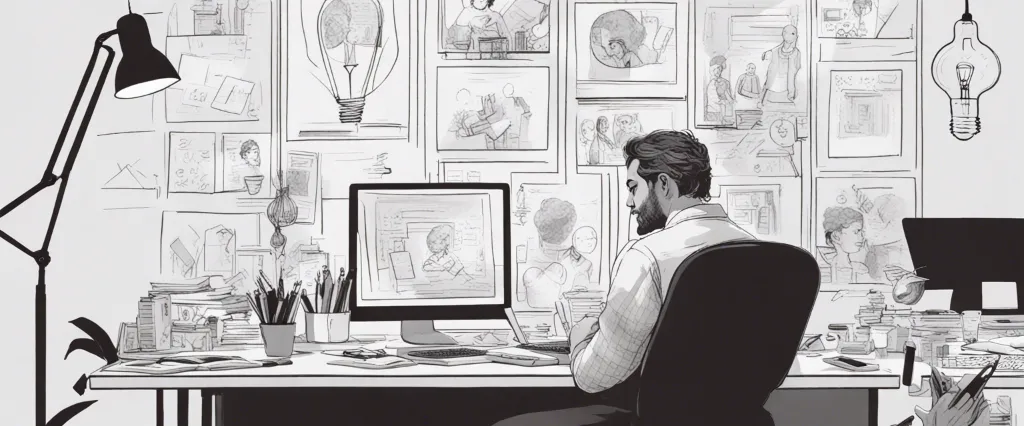In Design Is a Job by Mike Monteiro, author Mike Monteiro offers an honest and insightful guide to the world of design as a profession. With a wealth of experience as a designer and co-founder of Mule Design Studio, Monteiro taps into the realities of working in this industry and provides invaluable advice for designers at all stages of their careers. Through this practical and no-nonsense book, Monteiro empowers designers to embrace the business side of their work and become effective advocates for their own value and the impact of their designs. With his trademark wit and candor, Monteiro skillfully navigates the complexities of design as a job, making this book an essential read for anyone looking to succeed and thrive in the design industry.
Chapter 1:Understanding the role of design in business
Chapter 1 of “Design is a Job” by Mike Monteiro, titled “Understanding the Role of Design in Business,” provides an introduction to the crucial relationship between design and business success. Monteiro emphasizes that design, far from being just an aesthetically pleasing aspect of a product or service, is a fundamental driver of business growth and profitability.
The chapter begins by debunking the popular misconception that design is solely concerned with making things look pretty. Instead, Monteiro explains that design is about solving problems and improving experiences for users. Designers have the unique ability to bridge the gap between a company’s goals and the needs of its customers. By understanding user behaviors, motivations, and pain points, designers can create solutions that not only delight users but also align with business objectives.
Monteiro emphasizes the importance of integrating design into the business strategy right from the beginning. He advises designers to collaborate closely with other stakeholders, such as product managers and engineers, to ensure that design decisions are based on a deep understanding of market needs and constraints. This collaboration also helps break down the misconception that design is separate from the rest of the business, fostering a more holistic approach.
Furthermore, the chapter highlights the significance of good communication skills for designers. Monteiro stresses that designers must be able to articulate the value and impact of their work, justify design decisions, and effectively present their ideas to clients and colleagues. By mastering these skills, designers can position themselves as indispensable partners in the business.
In summary, Chapter 1 of “Design is a Job” underscores the profound role that design plays in business success. It showcases how design goes beyond aesthetics to solve problems, align with business goals, and enhance user experiences. By integrating design early on, collaborating with stakeholders, and mastering communication skills, designers can position themselves as invaluable contributors to any organization’s success.
Chapter 2:Building strong client relationships and effective communication
Chapter 2: Building strong client relationships and effective communication of the book “Design Is a Job” by Mike Monteiro explores the significance of fostering healthy client relationships and the importance of effective communication in the field of design.
The chapter begins by emphasizing the notion that designers are not just creators of beautiful things; they are also businesspeople with a responsibility to manage client relationships. Monteiro emphasizes the idea that one of the most crucial aspects of design is the ability to earn the client’s trust. Trust is built through open and honest communication, setting clear expectations, and delivering on promises.
Effective communication plays a pivotal role in establishing trust and maintaining successful client relationships. Monteiro stresses the importance of active listening, understanding the client’s goals, and asking the right questions. He encourages designers to focus not only on what the client wants but also on what they need, as it is the designer’s role to guide them in making the best decisions for their business.
Monteiro highlights the necessity of documentation and establishing clear contracts to avoid misunderstandings or miscommunication. By providing written documentation, designers can ensure that all parties are on the same page, preventing potential disputes down the line.
Additionally, the chapter delves into the process of presenting and selling design work to clients. Monteiro advises designers on how to effectively present their ideas, assert their expertise, and handle constructive criticism. He emphasizes the importance of conveying design decisions to clients in a way that aligns with their goals and objectives.
In summary, Chapter 2 of “Design Is a Job” emphasizes the significance of building strong client relationships by earning their trust, establishing clear communication, and delivering on promises. Through active listening, understanding clients’ needs, and effective presentation skills, designers can cultivate successful partnerships that lead to the creation of impactful and meaningful design solutions.
Chapter 3:The importance of clear project scope and expectations
Chapter 3 of “Design Is a Job” by Mike Monteiro emphasizes the significance of establishing clear project scope and expectations in the field of design. Monteiro stresses that a lack of clear goals and boundaries can lead to miscommunication, dissatisfaction, and ultimately an unsuccessful project.
The author begins by acknowledging that designers often get caught up in the excitement of the creative process, overlooking the importance of establishing a solid project scope. By not defining the project’s limitations and objectives from the beginning, designers set themselves up for potential disaster. Monteiro emphasizes that it is crucial to have a clear vision of what the project aims to achieve, including any constraints, objectives, and desired outcomes.
To effectively define project scope, Monteiro suggests a three-step approach: identify boundaries, define objectives, and establish deliverables. Boundaries serve as the project’s constraints, determining what is and what isn’t part of the scope. Objectives outline the goals and purpose of the project, allowing everyone involved to align their efforts towards a common goal. Lastly, deliverables are concrete outcomes that provide a tangible measure of progress and success.
Moreover, Monteiro highlights the importance of managing client expectations. By setting clear expectations from the start, designers can avoid misunderstandings and maintain a healthy client relationship. He advises designers to establish open communication channels, clarify project milestones, and manage client feedback effectively to ensure a smooth workflow.
In summary, Chapter 3 reiterates the critical role of having clear project scope and expectations in design work. By defining project boundaries, objectives, deliverables, and effectively managing client expectations, designers can lay a solid foundation for successful projects and avoid potential pitfalls.
Chapter 4:Strategies for pricing and contracts in design work

Chapter 4 of “Design Is a Job” by Mike Monteiro focuses on strategies for pricing and contracts in design work. Monteiro emphasizes the significance of creating fair and comprehensive contracts to ensure a successful client-designer relationship.
Monteiro reveals that pricing design work can be challenging, as the value of design is often subjective. He encourages designers to abandon hourly rates and instead focus on the value they bring to the project. By quantifying the impact of their work on the client’s business and aligning pricing accordingly, designers can establish an equitable price. Monteiro advises considering the complexity, expertise, and potential outcomes of the project when determining the price.
Moreover, Monteiro stresses the importance of clear and thorough contracts to protect both parties involved. He advises designers to create contracts that outline the project scope, deliverables, timelines, and payment terms. Contracts should also articulate the intellectual property rights and include clauses for handling project changes or termination. By having a well-defined contract, designers can confidently address any misunderstandings or scope creep that may arise throughout the project.
Monteiro recommends avoiding speculative work, commonly known as “spec work,” where designers provide free or unpaid work to obtain a project. He argues that spec work devalues the profession and encourages clients to take advantage of designers. Instead, Monteiro encourages designers to focus on creating a strong portfolio and establishing trust with clients through clear communication and referrals.
In conclusion, Chapter 4 of “Design Is a Job” highlights the importance of establishing fair pricing and comprehensive contracts in design work. By moving away from hourly rates and assessing the value they bring, designers can ensure their pricing aligns with the impact of their work. Clear and thorough contracts protect both designers and clients, setting expectations and preventing disputes.
Chapter 5:Collaborating with clients and managing feedback
Chapter 5 of “Design Is a Job” by Mike Monteiro focuses on the importance of collaborating with clients and effectively managing feedback in the design process. Monteiro highlights that design is a collaborative effort, and the success of a project relies on maintaining a productive relationship with clients.
The chapter emphasizes the need for a clear communication process with clients, emphasizing the importance of setting expectations early on. Monteiro urges designers to establish a clear scope of work, project timeline, and deliverables. By doing so, both parties can ensure they have a shared understanding of the project’s objectives, minimizing misunderstandings along the way.
Furthermore, Monteiro stresses the significance of incorporating clients’ insights and feedback into the design process. He acknowledges that clients often have valuable knowledge about their audience or industry, and designers should take advantage of this expertise. However, he also highlights the importance of interpreting clients’ feedback effectively and not compromising on design principles or expertise. By differentiating between subjective and objective feedback, designers can address clients’ concerns while maintaining the project’s integrity.
Additionally, the chapter emphasizes the importance of presenting design work effectively. Monteiro advises designers to prepare persuasive arguments that justify design decisions. By providing solid reasoning behind their choices, designers can navigate potential conflicts and successfully advocate for their design choices.
Overall, Chapter 5 of “Design Is a Job” underscores the significance of collaboration and effective feedback management in the design process. It emphasizes the need for clear communication and setting expectations, while also recognizing the value of clients’ insights. By applying these principles, designers can build strong client relationships and deliver successful design projects.
Chapter 6:Balancing creativity and practicality in design projects
Chapter 6 of “Design Is a Job” by Mike Monteiro focuses on the importance of balancing creativity and practicality in design projects. Monteiro emphasizes that while creativity is essential for producing innovative and visually appealing designs, practicality is equally crucial for ensuring the design meets the client’s needs and objectives.
The chapter begins by highlighting the common misconception that creativity is only about artistic expression and ignores the practical aspects of design. Monteiro argues that a successful designer must consider both creative and practical elements throughout the design process. He emphasizes that design decisions should always be driven by the project’s goals and requirements, rather than solely by personal artistic flair.
Monteiro suggests that a core skill of a designer is being able to translate creative ideas into practical designs that effectively solve the client’s problems. He suggests that designers should first understand the project’s objectives, target audience, and limitations before diving into the creative process. By doing so, designers can ensure that their creativity is directed towards achieving the desired outcomes.
Furthermore, the chapter emphasizes the importance of effective communication between the designer and the client. Monteiro stresses that designers must be able to explain their creative decisions in a practical and understandable manner to the client. Balancing creativity with practicality requires the designer to articulate how the chosen design approach aligns with the project’s requirements and will effectively address the client’s objectives.
In summary, Chapter 6 of “Design Is a Job” underscores the significance of merging creativity and practicality in design projects. By considering both aspects, designers can create functional and aesthetically pleasing designs that effectively meet the client’s needs and goals. Effective communication and understanding the project’s objectives are vital in achieving this balance.
Chapter 7:Delivering high-quality work and meeting deadlines
Chapter 7 of “Design Is a Job” by Mike Monteiro focuses on delivering high-quality work and meeting deadlines in the design industry. Monteiro emphasizes the importance of both aspects in building a successful career and reputation as a designer.
The chapter begins by stressing the significance of maintaining professionalism in all interactions with clients. Monteiro advises designers to clearly communicate expectations and limitations, ensuring that clients understand what is expected of them and what they can expect in return. By establishing realistic deadlines and delivering on time, designers can build trust with clients and create a positive work environment.
Monteiro also highlights the significance of quality in design work. He emphasizes that the final product should always meet and hopefully exceed the client’s expectations. The author urges designers to be passionate about their craft and treat each project as an opportunity to create meaningful work. By going the extra mile and paying attention to details, designers can improve the quality of their work and stand out from the competition.
To meet deadlines effectively, Monteiro encourages designers to stay organized and to be transparent about their progress with clients. He advises against procrastination and stresses the importance of time management. Monteiro also suggests that designers should never sacrifice the quality of their work just to meet a deadline; instead, they should communicate any delays or potential issues to the client and work together on finding a solution.
Overall, Chapter 7 emphasizes that delivering high-quality work and meeting deadlines are essential for success in the design industry. By maintaining professionalism, being passionate about their work, and effectively managing time, designers can build strong relationships with clients and establish a reputation for excellence.

Chapter 8:Advocating for the value of design and professional ethics
Chapter 8 of “Design Is a Job” by Mike Monteiro focuses on advocating for the value of design and the importance of professional ethics in the field.
Monteiro highlights the need for designers to understand the value their work brings to the table. He emphasizes that design is not just about making things look pretty, but rather a strategic tool that solves problems and adds value to businesses. Designers must be confident in their abilities and articulate the value they bring to their clients or employers.
To advocate effectively, Monteiro suggests framing design discussions in terms of business objectives and outcomes. Instead of focusing solely on design aesthetics, designers should demonstrate how their solutions align with the overall goals of the organization. By speaking the language of business, designers are more likely to be taken seriously and have their ideas implemented.
Additionally, professional ethics play a crucial role in design. Monteiro emphasizes that designers have a responsibility to uphold ethical practices and to be honest with their clients. This involves being transparent about the value, costs, and limitations of design work. Monteiro stresses the importance of resisting unethical requests and challenging clients who may want to compromise the integrity of the work.
Ultimately, Monteiro argues that designers must advocate for their profession and educate clients, colleagues, and stakeholders about the value of design. By clearly articulating the impact and potential outcomes, designers can position themselves as trusted advisors and indispensable contributors to the success of a business or project.
After Reading
In conclusion, Mike Monteiro’s book “Design Is a Job” serves as a comprehensive guide for designers. With a conversational and humorous tone, Monteiro emphasizes the importance of professionalism, communication, and collaboration in the field of design. He provides valuable insights into the business aspects of design, such as contracts, pricing, and dealing with clients. Furthermore, Monteiro stresses the ethical responsibilities of designers and how their work can impact society. By encouraging designers to approach their profession as a serious job, he empowers them to confidently navigate the industry and make a meaningful impact with their work. Ultimately, “Design Is a Job” challenges conventional notions of design and instills a sense of purpose and accountability in its readers.
1. The Design of Everyday Things” by Don Norman – This classic book explores the principles of good design and provides valuable insights into how design impacts our daily lives. Don Norman emphasizes the significance of user-centered design and discusses the psychology behind effective design choices.
2. The Non-Designer’s Design Book” by Robin Williams – A must-read for anyone new to design, this book breaks down design concepts into simple, understandable terms. Robin Williams explains the basics of visual communication, typography, color theory, and layout, making it accessible for beginners.
3. Sprint: How to Solve Big Problems and Test New Ideas in Just Five Days” by Jake Knapp, John Zeratsky, and Braden Kowitz – While not solely focused on design, this book is highly relevant for designers working in a fast-paced environment. It presents a step-by-step framework for running design sprints, enabling teams to quickly prototype and test ideas to find the best solutions.
4.”Creative Confidence: Unleashing the Creative Potential Within Us All” by Tom Kelley and David Kelley is an inspiring guide that empowers individuals to tap into their innate creativity. With practical exercises and real-world examples, it encourages readers to embrace their creativity and apply it to all aspects of life, fostering innovation and problem-solving.
5. “Don’t Make Me Think, Revisited: A Common Sense Approach to Web Usability” by Steve Krug – Focusing on web design, Krug’s book emphasizes the importance of creating intuitive and user-friendly interfaces. With a conversational and humorous tone, he offers practical tips for improving website usability, benefiting both designers and clients.
These books will expand your understanding of design, broaden your skillset, and provide valuable insights into various aspects of the creative process.




